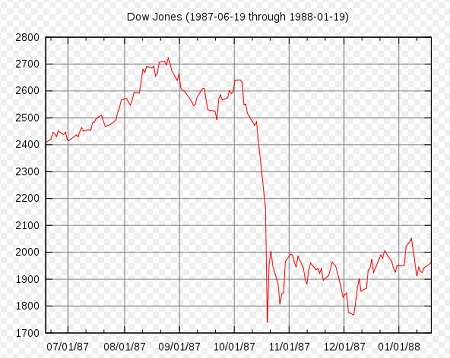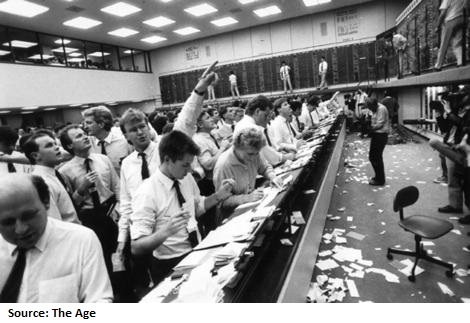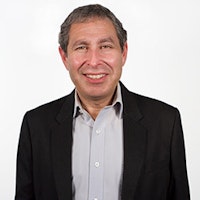Lessons from the October 1987 crash
Summary: Three decades ago, global stock markets went into complete meltdown, wiping out the wealth of millions of investors across the world, including many Australians. This week it's worth revisiting those events and overlaying them with the current market conditions.
Key take-out: For investors, the key is to focus on the fundamentals of what you are investing in, and to be acutely aware of the dangers of overborrowing.
This year's Nobel Prize winner in economics, Professor Richard Thaler, made a disturbing admission last week when asked to interpret the present conditions on the US stock market.
Recognised for his ground-breaking research into behavioural economics at the University of Chicago, Thaler said he could not explain the “miniscule volatility in the stock market” in the context of rising concerns around global geopolitical and economic events.
“We seem to be living in the riskiest moment in our lives, and yet the stock market seems to be napping. I admit to not understanding it. Psychologists have often talked about animals freezing or running, and it seems like investors are in freeze mode.”
It was an interesting interpretation of investor psychology, especially given his timing. This Thursday marks the 30th anniversary of the October 1987 stock market crash and, as the US stock market continues to break new records, some experts are becoming concerned that the market's fundamentals are not stacking up.
The US stock market set a new milestone once again overnight, breaking through 23,000 points for the first time -- more than 4,600 points, or 16 per cent, higher than where it sat this time last year before the election of US President Donald Trump.
But can the US market keep charging ahead? Hindsight, of course, is a wonderful thing. Back in 1987, as stock markets around the world moved further and further into record territory, there was a sense the party would never end.
Mergers and acquisitions activity was rife, as corporate raiders borrowed large swathes of capital from banks and debt markets and paid inflated prices to buy up other companies and expand their reach. Stock prices soared, often just in anticipation that a takeover bid could be coming.
By the end of August 1987, the US market had risen by 44 per cent in 12 months. Just about anyone with some spare capital to invest was in the market, with many small investors who had never even owned shares before buying into stocks that, on most accounting measures, were heavily overvalued. To make things worse, many had borrowed up to the hilt, taking out second mortgages on their homes, just to buy into the stock market dream. Something had to give, and it did.
The first market sparks
On Wednesday, October 14, 1987, the US market dropped a record 3.8 per cent amid rampant selling as the first signs of investor nervousness began to take hold. Many put the sell-off down to geopolitical concerns, overlaid by high interest rates and the sense that many companies were too heavily in debt. 
The selling rout continued the next day, with the Dow Jones Industrial Average falling another 2.4 per cent, followed by a new record 4.6 per cent drop on the Friday.
Then, on Monday, October 19, after having lost 11 per cent in value over the preceding three trading sessions, the Dow plunged 22.6 per cent over a few frantic hours as large-scale computerised institutional selling triggered mass panic among retail investors.
By the end of the session, a record 600 million trades had been recorded on the New York Stock Exchange and the market had lost more than $US500 billion in value. In today's value terms, the same percentage downturn would have wiped off more than $US5 trillion from the market.
The Dow's 508 point collapse sent other stock markets around the globe into freefall, ours included.
The onset of Black Tuesday
As a then financial reporter on The Australian Financial Review, I knew Tuesday October 20 was going to be a massive working day. So did everyone else involved in financial markets, from brokers to fund managers and everyone in between.
Well prepared for the day's events, or so I thought, I walked down Collins Street in Melbourne to the Australian Stock Exchange. But, as I walked onto the trading floor, and stood behind a throng of stockbrokers standing shoulder to shoulder, I quickly realised I, like many, had underestimated what was about to occur.
The financial bloodbath that unfolded shook Australia's corporate sector to its foundations, sending scores of companies broke and many retail investors into bankruptcy.
The opening bell sounded, and all hell broke loose. On what became known as Black Tuesday here, the All Ordinaries Index plummeted 516 points, or 25 per cent, as panicked Australian and international investors sought to liquidate their positions en masse.
Standing at least 20 deep, the brokers shouted seemingly endless sell and buy orders recorded on sheets of paper to the chalkies manning the boards, who could barely keep up as they scrambled along the overhead walkway from one company to another to jot down the trades.
By midday, the share prices of Australia's biggest companies had dropped more than 20 per cent. And by the end of the trading session the floor was overflowing with paper.
My coverage of those momentous events appeared on page one of the AFR the next morning. There were no websites back then.
The memories of those exhausted, shell-shocked brokers and chalkies are hard to forget, not to ignore the near-term aftermath as lenders began calling in their loans. Corporate heroes quickly turned into villains, and many investors were forced to liquidate assets to pay off their debts.
Another person who remembers the events extremely well is Geoff Wilson, now chairman of Wilson Asset Management, who back in 1987 was based in New York City and working in institutional sales at McIntosh Hanson Hoare Govett (taken over after the crash by Merrill Lynch).
“The actual day was one of excitement and trepidation. What would the Dow do? The market started falling from the open and was down around 200 points late morning,” Wilson says.
“I had a lunch booked … and, as I was too distracted, I cancelled it. In the afternoon the Dow continued to fall until the close.
“In shock that night we all went out for a drink, not knowing what Tuesday might bring.
“It changed everything. I was of the view it would take years and years for the market to recover. Amazingly, the Dow was up to its previous crash high after two years. It made me realise the time to buy is when blood is running in the street. To take a long-term view when investing, and work against your emotions.”
Veteran stockbroker Brett Spork, a former chief executive of E*Trade Australia and an executive director of Macquarie Financial Services, was working in London at the time for a specialist Melbourne broker, selling Australian equities to UK funds.
“I guess my main recollection was the enormous storms that hit the UK on October 15 and 16. It was a surreal event, with winds gusting to 190kph – and over 15 million trees uprooted.
“I lived close to the city, so I had no trouble getting to work – but, for a few days, it was like a ghost town. With regards to UK fund managers, their Australian portfolio was generally one of their lesser worries.
“Having said that, I recall several being heavily invested in the “entrepreneurs” – Bond Corp, Bell Resources, Adsteam, and so on.”
InvestSMART's Head of Funds Management, Alastair Davidson, was working in the Japanese warrant market in London for Baring Securities.
“Monday 19th was a falling market, but not too bad. We were at dinner at a friend's house when someone said, ‘have you seen what's happening on Wall Street?'.
“It was deathly quiet on Tuesday morning as we were an over-the-counter market – usually the phones started at 7am and kept going until 5pm (I had three phones on my desk). Nobody calling and nobody was answering when I called – very strange. It was like that all week.”
Manny Pohl, chairman and chief investment officer of ECP Asset Management, was a partner at South African stockbroking firm Davis, Borkum Hare, which is now also owned by Merrill Lynch.
Pohl says investment values declined, but the real impact was on the business where volumes declined by 75 per cent overnight.
“In times of systemic trauma, not only do previously uncorrelated assets and markets become correlated, but liquidity disappears. So, it is prudent to ensure that a business has the ability to withstand a one in 100-year traumatic event, even though it is unlikely to eventuate.”
Learning from past mistakes
Perhaps Lee Iacocca, the then Chrysler Corp chairman, had the most pertinent quote of the time when he proclaimed the day after Black Tuesday: “The borrowing has to stop. The market slide was a shot right between the eyes that had better wake us all up to the simple fact that we can't keep romping forever on borrowed money.”
Thirty years on, and with several market corrections in between 1987 and now, including the more recent global financial crisis, there are strong lessons for all investors.
Focus on the fundamentals of what you are invested in, or are planning to invest in, and don't let greed get in the way.
With stock market valuations high, corporate and household debt levels running at record levels again, and interest rates on the rise globally, there's a message in there for everyone carrying too much debt on their shoulders.







